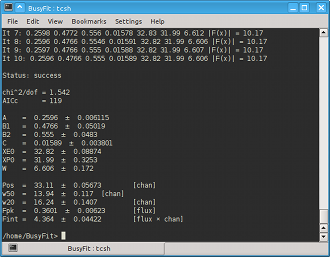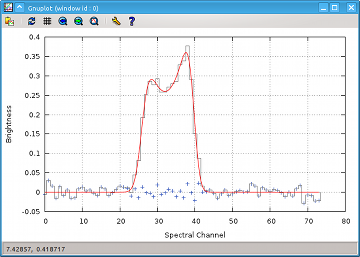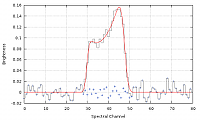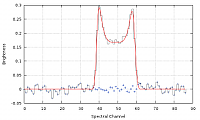BusyFit
Overview
Introduction
BusyFit is a stand-alone software for fitting the so-called Busy Function (Westmeier et al. 2014, MNRAS, 438, 1176) to the integrated spectrum of a galaxy for the purpose of parametrisation. It is entirely written in C++ and licensed under the GNU General Public License (version 3 or later). The latest version of BusyFit is available on GitLab.
Another Busy Function fitting software was developed by Russell Jurek and is also available on GitHub.
Screenshots


The two screenshots above show the output of a successful BusyFit run in the terminal window (left) and a plot of the spectrum with overlaid fit and residuals produced by BusyFit using gnuplot (right).
Requirements
The following software packages are required to successfully compile and run BusyFit:
- Linux / Unix operating system (e.g. Ubuntu, Mac OS X) with graphical user interface (optional; required for plotting the fitted spectrum) and shell (e.g. bash, tcsh)
- GNU Compiler Collection (GCC), including C++ compiler (g++)
- GNU Scientific Library (GSL), including development (dev) packages.
- GNU less (optional; required for help system)
- gnuplot (optional; required for plotting the fitted spectrum)
If you are running a GNU/Linux system on your computer, you will likely have all of these software packages either already installed or made available through your system’s package manager, so there should be no need to manually download and compile any of them.
GNU less and gnuplot are optional. The former is used to display the detailed help message and user manual when typing ‘busyfit -help’, while the latter is needed to automatically plot the fitted spectrum on the screen. Plotting can be disabled by invoking BusyFit with the ‘-noplot’ option.
Download
The latest version of BusyFit is available for download from GitLab.
Installation
For detailed installation instructions, please consult the README file included in the download package. Installation instructions are also available online on GitLab.
Usage
The BusyFit software package comes with its own internal help system and user manual. A simple overview of all available options will be displayed by calling ‘busyfit’ without any options or input file name. A more detailed user manual can be displayed by typing ‘busyfit -help’.
The following example illustrates how to use BusyFit in its most basic form:
The spectrum to be fitted is read from a simple text file (spectrum.txt in the example above) where the velocity and flux values of the spectrum must be located in two columns the positions of which are specified with the -c option (the third column for velocities, the fourth column for fluxes in the example above). Without the -c option, BusyFit will read the first two columns of the input file by default.
Please see the user manual for more detailed information on the available options.

